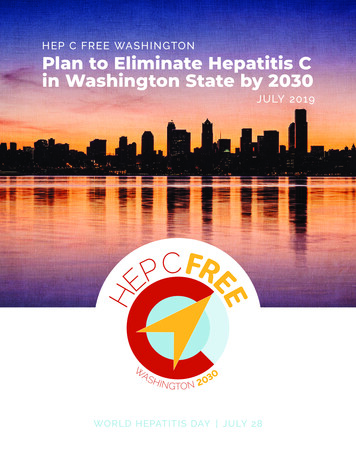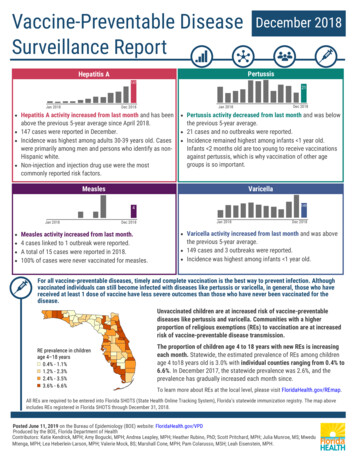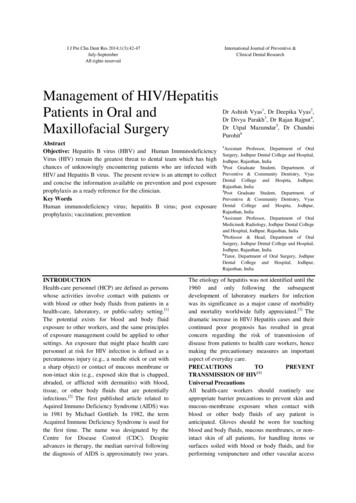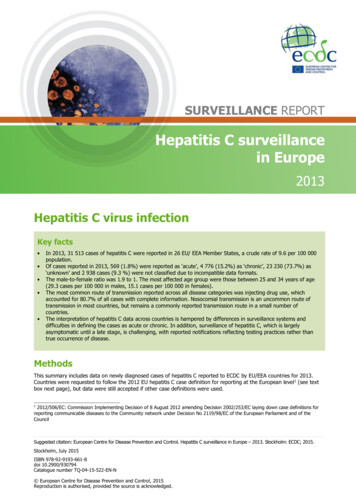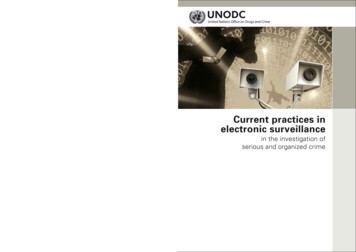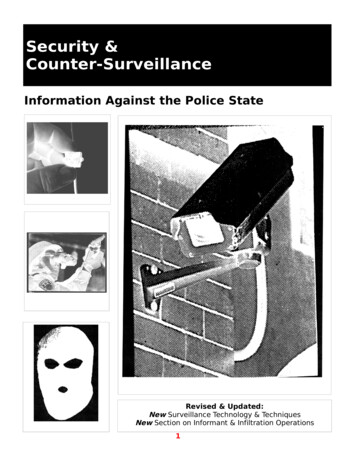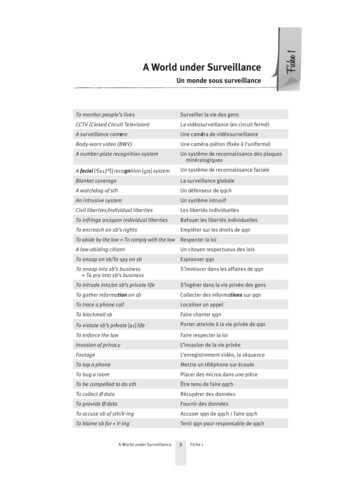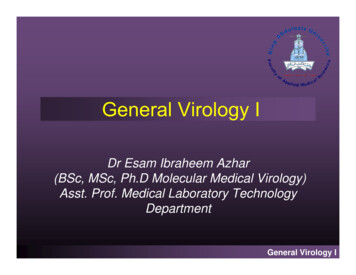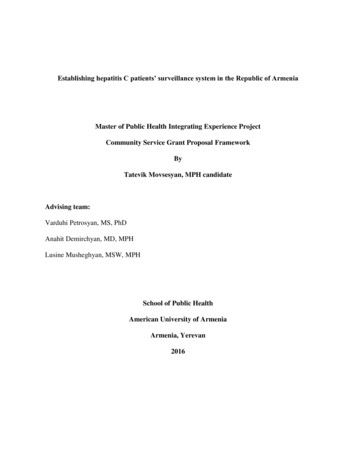
Transcription
Establishing hepatitis C patients’ surveillance system in the Republic of ArmeniaMaster of Public Health Integrating Experience ProjectCommunity Service Grant Proposal FrameworkByTatevik Movsesyan, MPH candidateAdvising team:Varduhi Petrosyan, MS, PhDAnahit Demirchyan, MD, MPHLusine Musheghyan, MSW, MPHSchool of Public HealthAmerican University of ArmeniaArmenia, Yerevan2016
Table of ContentsLIST OF ACRONYMS . IIIEXECUTIVE SUMMARY: . VI1. OBJECTIVES. 12. INTRODUCTION . 12.1 PREVALENCE AND INCIDENCE IN THE WORLD .12.2 SITUATION IN ARMENIA .22.2.1 Prevalence .22.2.2 Management of hepatitis B, C .32.2.3 Future actions .52.3 NATURAL HISTORY OF HCV INFECTION .62.4 TRANSMISSION OF HCV .72.5 VULNERABLE GROUPS .82.6 SCREENING/DIAGNOSIS .82.6.1 Clinical definition - EU 2008/426/EC standard .92.6.2 Laboratory diagnostic criteria for HCV infection .92.6.3 Follow-up screenings .112.7 TREATMENT .112.7.1 Treatment in Armenia .132.8 SURVEILLANCE SYSTEMS .133.METHODOLOGY . 153.1 CONCEPTUAL FRAMEWORK .153.2 IMPLEMENTATION PLAN SYNOPSIS .153.2.1 Public Health Surveillance .153.2.2 Public Health action .263.3 EVALUATION PLAN SYNOPSIS .303.3.1 Completeness .313.3.2 Validity .323.3.3 Treatment coverage .323.3.4 Cost-evaluation Analysis.324. PLANNING /BUDGET . 344.1 FIRST STAGE .344.1.1 Surveillance system staff .354.1.2 Software development .354.1.3 Training of software users .354.1.4 Educational programs .364.1.5 Treatment of patients diagnosed with HCV .364.1.6 Follow-up laboratory tests .374.2 SECOND STAGE .374.2.1 Detection of new cases .37i
4.2.2 Treatment of new cases .374.2.3 Follow-up laboratory test .374.2.4 The overall budget .385. ETHICAL CONSIDERATIONS. 386. REFERENCE LIST. 39APPENDIX 1: GROUPS OF PEOPLE WHO SHOULD DO MANDATORY ANTI-HCV OR ANTI-HCVAND HCV RNA TEST10 . 46APPENDIX 2: NATURAL PROGRESSION OF HEPATITIS C INFECTION22 . 49APPENDIX 3: PRICES OF HCV TESTS IN THE LABORATORIES OF ARMENIA (US )74–78 . 50APPENDIX 4: ESTIMATED COST OF THE TREATMENT COURSE PER PATIENT (CPP) AND COSTPER SUSTAINED VIROLOGIC RESPONSE (CPSVR) OF SELECTED PEGYLATEDINTERFERON/RIBAVIRIN AND DAA REGIMENS IN BRAZIL, MONGOLIA, AND UKRAINE (2015US )38 . 51APPENDIX 5: ESTIMATED TOTAL COST OF TREATING ALL PERSONS DIAGNOSED WITHCHRONIC HCV INFECTION IN BRAZIL, MONGOLIA, AND UKRAINE (2015 US ) WITH DAAREGIMENS38 . 52APPENDIX 6: PER PATIENT PRICE (FOR A TREATMENT COURSE) OF HCV TREATMENTMEDICATIONS AVAILABLE IN ARMENIA (US ) 79–81 . 53APPENDIX 7: CONCEPTUAL FRAMEWORK OF PUBLIC HEALTH SURVEILLANCE AND ACTION47. 54APPENDIX 8: THE FLOWCHART OF CASE-REPORTING.82. 55APPENDIX 9: RESPONSIBILITIES OF SOFTWARE USERS . 56APPENDIX 10: SCHEDULE OF TRAININGS . 58APPENDIX 11: BUDGET OF TREATMENT (INTERFERON/ RIBAVIRIN) OF ALREADY IDENTIFIEDCASES WITH INTERFERON/ RIBAVIRIN AND DAA (US ) . 59APPENDIX 12: TIMETABLE FOR THE FIRST YEAR . 60APPENDIX 13: BUDGET OF TREATMENT OF NEWLY DETECTED CASES WITH INTERFERON/RIBAVIRIN AND DAA (US ) . 61APPENDIX 14: BUDGET FOR THE FIRST YEAR (US ) . 62APPENDIX 15: BUDGET (PER ONE YEAR STARTING FROM THE SECOND YEAR) . 65ii
List of AcronymsHAVHepatitis A VirusHBVHepatitis B VirusHCVHepatitis C VirusHIVHuman Immunodeficiency VirusAIDSAcquired Immune Deficiency SyndromeWHOWorld Health OrganizationNCDCNational Center for Disease ControlRARepublic of ArmeniaMOHMinistry of HealthUSAUnited States of AmericaCDCCenter for Disease ControlHBsAgHepatitis B surface antigenEUEuropian UnionECEuropian CommissionNGONon-Governmental OrganizationsRNARibonucleic AcidPCRPolymerase Chain ReactionIUInternational UnitALTAlanine aminotransferaseASTAspartate aminotransferaseHCV RIBAHepatitis C Virus Recombinant Immunoblot AssayNATNucleic Acid TestIgMImmunoglobulin MIgGImmunoglobulin GAnti-HBcHepatitis V core antigenEIAEnzyme immunoassaysSGPTSerum glutamic pyruvic transaminaseDAADirect antiviral agentsiii
PEG-IFNPegylated interferonRBVRibavirinNSNonstructural proteinCPPCost per patientCPSVRCost per sustained virologic responseSVRSustained virological responseHTMLHyperText Markup LanguageIDIdentityCJSCClosed Joint State CompanyPPVPositive predictive ValueDALYDisability Adjusted Life YearsYLLYears of Life LostYLDYears of Lost due to DisabilityICERIncremental Cost-Effectiveness RatioIRBInstitutional Review Board/Committee on Human Researchiv
AcknowledgementsI would like to express my deepest acknowledgments to my advising team: to Dr.Varduhi Petrosyan for pushing me to work harder and be devoted to work that I am in charge, toDr. Anahit Demirchyan for showing me the right way (especially in development of the budget)and constructive comments, to Lusine Musheghyan for encouraging me and useful ideas. Iwould like to thank them for the patient guidance, faith, advice they have provided me and theireffort in developing this project throughout these months. I would like to thank my advisors fortimely feedback despite their busyness and important responsibilities. I have been incrediblylucky to have advisors who cared so much about my work.I would also like to mention Gayane Melik-Andreasyan for her help anddocuments/information that she provided me regarding the HCV situation in Armenia.Thanks to my MPH friends (Vahe Krmoyan, Nare Navasardyan, Zaruhi Arakelyan,Anush Mnatsakanyan and Shabitha Alexander) for believing in me and my abilities.v
Executive Summary:Objectives: The aim of the study is to propose establishing a surveillance system forhepatitis C infection in Armenia. This will rationalize collection and analysis of data, estimatethe burden of the disease, and contribute to developing and conducting effective public healthpolicy and intervention for prevention and timely treatment of hepatitis C infection.Introduction: In 2015, more than 185 million people around the world were infected withhepatitis C virus (HCV), of whom 350 000 die each year. In 2015, viral hepatitis was the 7thleading cause of mortality in the world. During the last decades, HCV infection demonstrates anincreasing trend in Armenia. In 2013, the prevalence of HCV among general population was 35%. The treatment of chronic HCV infection is focused on preventing further damage to liver toavoid life-threatening complications. There are two strategies for HCV treatment: using acombination of interferon and ribavirin or direct antiviral agents (DAA). Armenia uses the firstone, and no DAA medication is registered in the country. The state does not pay for the therapyof HCV while the cost of treatment in the local market is up to 16,000 US per person.Methodology: The proposal suggests to establish surveillance system of HCV infectionin Armenia consisting of six components: 1) case definition (clinical (EU 2008/426/EC standard)and laboratory standardization), 2) case reporting (demographic characteristics, clinical data,date, laboratory markers, potential source of inflammation and risk factors), 3) routine casedetection and data collection (via electronic software), 4) analysis (epidemiological (incidenceand prevalence) and specific (treatment costs, co-morbidities, etc.) reports) 5) dissemination ofresults among key policy and decision makers and 6) recommendations for further actions(treatment, development of national guideline, educational programs). The evaluation of theproject is focused on the quality of the surveillance system (completeness and validity).Budget: The budget for the first year is estimated as 592,132,310 US , and the annualbudget for the second and following years is expected to be at least 11,363,090 US .vi
1. ObjectivesThe aim of the study is to propose establishing a surveillance system for hepatitis Cinfection in Armenia. Developing a national surveillance system for hepatitis C virus infectioncould provide a useful tool for estimating the burden of the disease and following the trend of thedisease in the Republic of Armenia. The surveillance system will rationalize collection andanalysis of data on the incidence of hepatitis C infection. Information gained from the systemcan be used to: Detect high-risk population groups Identify clusters or outbreaks of hepatitis C Identify sources of exposure to prevent further transmission Identify geographic areas where public health intervention should be conducted Develop and conduct effective public health policy and intervention.12. Introduction2.1 Prevalence and incidence in the worldHepatitis C is an infectious disease caused by the hepatitis C virus (HCV).2 According torecent estimates, in 2015, more than 185 million people around the world were infected withHCV, of whom 350 000 die each year.2–4 In September 2015, the World Health Organization(WHO), World Hepatitis Alliance and the Scottish Government organized the First WorldHepatitis Summit. They issued the Glasgow Declaration on hepatitis which states that there are400 million people in the world living with hepatitis C and B infections, and 1.4 million peopledie every year from complications of viral hepatitis in the world.5,6 In 2015, viral hepatitis wasthe 7th leading cause of mortality in the world.61
There is a geographical difference in the patterns of Hepatitis C infection.3,7 Theprevalence of HCV is low in high-income countries (North America, Western Europe, andAustralia). The highest incidence rates of HCV are estimated in middle- and low-incomecountries in Africa and Central and East Asia.3,72.2 Situation in Armenia2.2.1 PrevalenceArmenia, a lower-middle income country, had a 3-5% prevalence of HCV among thegeneral population in 2013.8–11 It is the third highest rate among post-Soviet countries (Georgia6.7% and Uzbekistan 6.5%).11 Of the patients infected with hepatitis C in Armenia, 44% haveHCV genotype 1, 37% have genotype 3 and 19% have genotype 2.8,9,12 The prevalence ofHCVamong different groups is: injecting drug users 64.0% imprisoned persons 36.3% patients getting hemodialysis 29.4% commercial sex workers 10.2% patients with tuberculosis 9.0% healthcare workers 6.8% oncological patients 3.1% healthy population 3.6%.8,92
2.2.2 Management of hepatitis B, CIn 2015, the Minister of Health of the Republic of Armenia approved the order N3691-A“Methodological guideline for epidemiological management of viral hepatitis B, C”.10 Themethodological guideline is for: All the medical institutions that provide medical care and services for detection andfurther management of viral hepatitis C, B cases in the whole territory of the Republic ofArmenia Professionals of the National Center for Disease Control of the Republic of Armenia,who are included in epidemiological control of hepatitis C, B.The epidemiological control of viral hepatitis C and B is done by the National Center forDisease Control of the Republic of Armenia (NCDC), which provides methodologicalmanagement of prevention and regular control activities of HCV and HBV infections in eachgeographical area including registration and reporting of acute, first time accrued chronic viralHCV infection, HBV cases, and Anti-HCV positive blood persons. The registration form(“Registration form of infectious and parasitic diseases”) is approved by N21-n order of theMinister of Health of RA issued on 20.10.2008.332.2.2.1 Case detection and data collectionAccording to the methodological guideline, detection of Hepatitis C, B is done by healthcare workers (not specific infectious disease specialists or hepatologists) in the medicalinstitutions.The detection criteria are: Clinical – anti-HCV positive133
Epidemiological - anamnesis, contact with hepatitis C, B patient, blood transfusion,invasive interventions. Laboratory - quick test (presence of HCV antibodies in the blood) and nucleic acid testfor HCV RNA.Patietnts with antibodies of HCV in the blood need to undergo laboratory tests to detectperesence of HCV RNA in the blood. Patinents with possitive answer are determined as patientswith chronic hepatitis C infection. Patients with negative answer are determined as patients withacute hepatitis C infection. These patients with acute hepatitis C need to do HCV RNA test atleast during two years, every six months.10According to the guideline, the diagnosis should be set within 14 days for organizing andimplementing successful treatment, epidemiological and preventative events on time. Anti-HCVpositive persons, who are HCV-RNA negative should regularly test for two years but not less thanonce in six months. The guideline states that there are groups (Appendix 1) of people from threespheres who should do mandatory Anti-HCV test to find the antibodies in the organism and thereare some groups who should do mandatory Anti-HCV and HCV RNA tests: Transplantation (before taking donor substance) Donor service (testing blood for urgent blood transfusion when there is no informationabout anti-HCV and Hepatitis B surface antigen (HBsAg) screened donor blood) Hospital admission departments (for emergency medical intervention).102.2.2.2 Case registration and case reportingAfter detecting cases with hepatitis C infection, the health care worker registers theepidemiological indicators (information about epidemiological anamnesis, contact with a person4
infected with HCV, hemodialysis, and information about invasive procedures) in the medicalcard of the patient.14 Case registration and reporting of hepatitis B and C is approved by theorder of Ministry of Health N 35-N issued on 17.12.2010.15 The chief of the medical institutionis responsible for case reporting.2.2.3 Future actionsHCV professionals from MOH now work on the project “The National strategy and listof events for fighting against viral hepatitis C in Armenia 2016-2020” which consists of ninestrategies:1.Development of national strategy and support to fighting against HCV at thegovernmental level. The objective of the strategy is to strengthen the integrated system of antiHCV actions, planning coordination, management, financing and monitoring at national andlocal levels.2.Development and implementation of treatment strategy corresponding to the internationalapproaches at all levels.3.Development and implementation of a system for HCV treatment medications usecorresponding to the international methodology.4.Ensuring the occupational safety among healthcare workers in terms of being protectedfrom getting HCV. The objective of the strategy is the reduction of cases of nosocomialinfection among healthcare workers.5.Development of laboratory control system of viral HCV. The aim of the strategy is toensure the continuous process of diagnosing and early detection of HCV.6.Improvement of epidemiological control of HCV.5
7.Strengthening cooperation with the HIV / AIDS national program to fight against HepatitisC / HIV combined infection. The objective of the strategy is to prevent transmission of HCVamong HIV / AIDS patients.8.Development of HCV campaign on health education and healthy lifestyle in the population.9.Monitoring and evaluation of program implementation (Melik-Andreasyan G., MD, Ph.D.,ScD, Professor, Director of The Research Institute of Epidemiology, Virology and MedicalParasitology after A.B. Alexanian, oral communication, 30 March 2016).2.3 Natural history of HCV infectionHepatitis is a term that is used to describe inflammation of the liver which can be causedby hepatitis viruses (the main cause of hepatitis), other toxic substances (e.g. alcohol or somedrugs) and some autoimmune diseases.2,16 The HCV is a RNA (ribonucleic acid) virus which ishighly mutable.17 The genome analysis of the virus has identified at least six genotypes (1, 2, 3,4, 5, 6) but only four of them (1, 2, 3, 4) are common.17 The genotype is particularly importantas it determines the duration of the treatment and the medications for the therapy.4,17,18 Thedistribution of genotypes is different in various countries. In the United States, 70% of thedisease is caused by genotype 1, meanwhile, in the Middle East 91% of the patients are infectedwith the virus of the genotype 4.3 Having multiple genotypes makes the development of avaccine very challenging,17 and there is no hepatitis C vaccine nowadays.19 A person can beinfected with multiple genotypes simultaneously.Hepatitis C causes acute (symptoms of HCV infection appear within six months ofacquiring infection) and chronic (symptoms of HCV infection appear six months or later afteracquiring infection) infection.4 Approximately 20% –30% of infected persons developsymptoms of acute illness such as fatigue, abdominal pain, poor appetite, or jaundice (yellowing6
of skin and the whites of the eyes).20 According to the Center for Disease Control (CDC) andPrevention of the United States of America (USA), of those infected with HCV: 75–85% develop chronic infection 60–70% develop chronic liver disease 5–20% develop cirrhosis over a period of 20–30 years 1–5% die from the consequences of chronic infection (liver cancer or cirrhosis).20About 15% of people who have been infected and have strong immune system canspontaneously eliminate the infection without treatment, and anti-HCV antibodies will stay intheir organism during their whole life.18,19 The others with weaker immune system will remaininfected, and the virus will continue living in the cells of the human body.17Being infected is initially asymptomatic until liver failure becomes clinically expressedand available assays do not distinguish acute from chronic infection.18 About 60-80% of patientsinfected with acute HCV do not feel any symptoms.18,19 Only some patients with acute infectionmay exhibit fever, fatigue, decreased appetite, nausea, vomiting, abdominal pain, dark urine,grey-colored faces, joint pain and jaundice.19 Chronic HCV infection can cause liver failure,liver cirrhosis, and hepatocellular carcinoma.21 The natural progression of hepatitis C infectionis described in Appendix 2.222.4 Transmission of HCVThe most expedient way of virus transmission is blood (e.g. renal dialysis and unscreenedblood transfusions, use of unsterile needles and contaminated drug solutions, cosmeticprocedures (such as tattooing and body piercing)). People can also be infected by mucosalexposures to blood or serum-derived fluids (e.g., birth to an infected mother, unprotected sexual7
relations with infected partner).4,7,19 Hepatitis C is not transmitted via breast milk, food, waterand/or by casual contact, such as hugging, sharing food or drinks with an infected person.182.5 Vulnerable groupsAccording to the WHO, there are groups of people who are vulnerable to being infectedwith HCV: Individuals who received blood transfusions without HCV blood screening Intravenous drug users Patients on dialysis Health care workers (where there is a risk of HCV transmission) Babies born to mothers known to be infected with HCV Regular sexual partners of patients infected with HCV Persons with Human Immunodeficiency virus (HIV) infection Prisoners and previously incarcerated persons Individuals who received medical or dental treatment where infection control may bepoor People who have tattoos, body piercing, and other procedures dealing with blood ofdifferent clients (such as manicure or pedicure).2,4,7,16,18,19,232.6 Screening/DiagnosisSince in the majority of cases the infection has no symptoms, usually people get testedwhen they already have the chronic HCV infection. The process of liver cell damage maycontinue long years after initial infection.248
The screening process consists of two steps: 1) to identify the presence of anti-HCVantibodies in order to detect if the person has ever been infected with the virus or not; 2) toconduct a Polymerase chain reaction (PCR) test - a nucleic acid test for HCV RNA to establishwhether the individual has chronic HCV infection or not, and if the infection is present thegenotype of the infection.18 Prices of the tests available in Armenia are presented in Appendix 3.2.6.1 Clinical definition - EU 2008/426/EC standardAcute HCV infection: either a documented negative HCV antibody laboratory test resultfollowed within 6 months by a positive test (as described in the laboratory criteria for diagnosis)or an acute illness with a discrete onset of any sign or symptom consistent with acute viralhepatitis (e.g., anorexia, abdominal discomfort, nausea, vomiting), and either a) jaundice, or b)serum alanine aminotransferase (ALT) levels 400 IU/L.1,25–28Chronic HCV infection: most HCV-infected persons are asymptomatic; however, manyhave chronic liver failure, which can range from mild to severe.1,25–28 Hence, there are noclinical diagnostic criteria for chronic HCV infection.2.6.2 Laboratory diagnostic criteria for HCV infectionThe laboratory diagnostic criteria for acute HCV include one or more of the following:1.Anti-HCV screening test (identifying antibodies to hepatitis C virus) positive with asignal to cut-off ratio predictive of a true positive as determined for the particular assay asdefined by the Center for Disease Control and Prevention of the United States of America, or2.Hepatitis C Virus Recombinant Immunoblot Assay (HCV RIBA) positive, or3.Nucleic Acid Test (NAT) for HCV RNA positive and, meets the following two criteria:A.IgM (Immunoglobulin M) antibody to hepatitis A virus (IgM anti-HAV) negative9
B.IgM antibody to hepatitis B core antigen (IgM anti-HBc) negative.1, 14, 19, 20The laboratory criteria for chronic HCV include one or more of the following: Anti-HCV positive (repeat reactive) by EIA (enzyme immunoassays), verified by anadditional more specific assay (e.g., RIBA for anti-HCV or nucleic acid testing for HCV RNA), HCV RIBA positive, Nucleic acid test for HCV RNA positive, Report of HCV genotype, Anti-HCV IgM Anti-HCV IgG (Immunoglobulin G) avidity index Observation of serial changes in viral load (viral load fluctuations 1 log and HCV RNAlevels 100,000 IU/mL) Anti-HCV positive with a signal to cut-off ratio predictive of a true positive asdetermined for the particular test as determined and posted by CDC.1,25–32According to these criteria, CDC classifies cases into two groups: confirmed andprobable. Confirmed acute HCV is the case that meets the clinical case definition and islaboratory confirmed, and is not known to have chronic hepatitis C.1,25–28 Confirmed chronicHCV is the case that is laboratory confirmed and that does not meet the case definition for acutehepatitis C.1,25–28 Probable is the case that is anti-HCV positive by EIA and has alanineaminotransferase (ALT or SGPT( Serum glutamic pyruvic transaminase)) values above the upperlimit of normal, but the anti-HCV EIA result has not been verified by an additional more specificassay or the signal to cut-off ratio is unknown.1,25–2810
2.6.3 Follow-up screeningsAfter being diagnosed with HCV, patients need to take routine test to monitor the effectsof the treatment. Each 6 weeks patients need to check ALT and AST levels and do HCV RNAtest. After successfully finishing the treatment patients need to do HCV RNA test twice; 6months and 2 years after the treatment is over.332.7 TreatmentThe treatment of chronic HCV infection is focused on preventin
combination of interferon and ribavirin or direct antiviral agents (DAA). Armenia uses the first one, and no DAA medication is registered in the country. The state does not pay for the therapy of HCV while the cost of treatment in the local market is up to 16,000 US per person.
